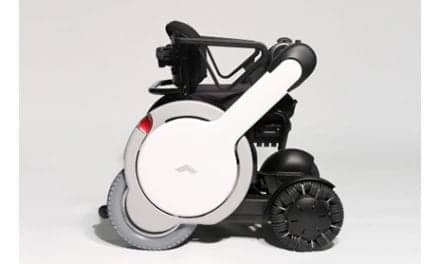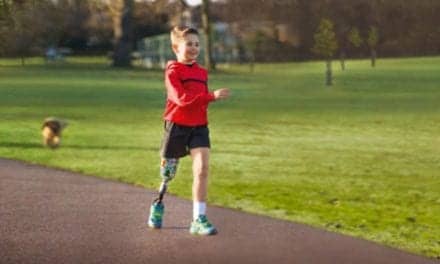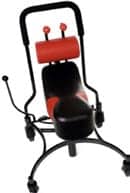 |
The landscape occupied by seating-and-positioning systems turned a shade more innovative in the last year or so—good news on the one hand for therapists in search of better options for their clients, but bad news on the other for therapists struggling to stay abreast of it all.
“Every manufacturer of seating-and-positioning systems today has something truly unique and fabulous to offer, which means the challenge is to constantly educate ourselves on what’s available and then try to understand the most appropriate applications and usage situations, because no single maker has something for every instance,” says Ginny Paleg, MS, PT, an NDT-certified pediatric physical therapist and a University of Maryland doctoral candidate from Silver Spring, Md; she serves as the APTA representative for pediatric section reimbursement and now pens the Clinical Challenges column for Rehab Management.
Lauren Rosen, PT, MPT, ATP, program coordinator for the Motion Analysis Center at St Joseph’s Children’s Hospital, Tampa, Fla, agrees that seating-and-positioning systems are continuing to improve, a sign that research and development remain prominent in the minds of manufacturers. Nonetheless, the pace of innovation seems to be slowing, she laments. “Five years ago, I’d attend a trade show like Medtrade and come home with 20 or 25 exciting new products, whereas this year I came home with about five such items,” she says.
One reason for this slow-down appears to be industry alarm over the impact national competitive bidding will have on profits. Ditto, the uncertainties surrounding the assignment of codes for new products, observers suggest.
PRESSURE POINTS
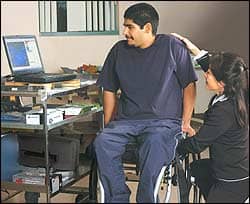 |
| Jan Furumasu, PT, ATP (far right), uses a seat-mapping system to evaluate client Joshua Monroy at Rancho Los Amigos National Rehabilitation Center, Downey, Calif. |
Still, wherever innovation is found, it tends to be impressive. For Jan Furumasu, PT, ATP, among the most stellar of such advances are systems that perform pressure mapping.
“In seating-and-positioning, there is a need for objective data—pressure-mapping systems can provide such data; however, the interpretation needs to be deciphered,” says Furumasu, who works as a physical therapy instructor at Rancho Los Amigos National Rehabilitation Center in Downey, Calif. “With pressure-mapping technology, it’s possible to know in readily grasped visual representations where the peak pressures are. This is especially helpful when configuring seating-and-positioning systems and when problem-solving pressure ulcer issues for clients who have little or no sensation—in other words, those most at risk for pressure sores.”
Rosen is also a user of pressure mapping, although sporadically. “I only pressure-map those clients who present with decubitus ulcerations that defy ready explanation or whose seating is more complex,” she says. “Ordinarily, I can look at someone sitting in their chair and quickly spot why they’re having a skin breakdown on one side versus the other. But there are times when it looks like the client is weight-bearing evenly and yet has problems on one side. That’s when I turn to pressure mapping.”
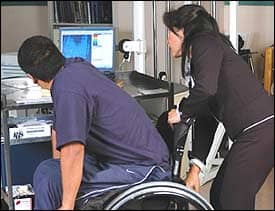 |
| Furumasu (right) monitors the mapping device, which can determine how far forward Monroy’s position should be to relieve pressure on his ischial tuberosities. |
Pressure mapping also is valuable for convincingly demonstrating that a therapist-chosen cushion is more appropriate for the client than the one demanded by the insurance company. “Pressure-mapping systems allow you to objectively compare cushions,” says Furumasu, who adds that her facility is also using its pressure-mapping systems to document pressure changes in patients who have undergone postoperative muscle flap surgeries with Bion implants to stimulate muscle contraction and circulation. “Pressure-mapping systems are good too as an educational aid in training clients to use pressure-relief techniques.”
At Rosen’s facility, the pressure-mapping system is one manufactured by Tekscan Inc of South Boston, Mass. “This product provides a very accurate interface between the client and the cushions,” she says, adding that she appreciates the device’s capacity for measuring those interface pressures with minimal interference thanks to its super-thin, flexible, contour-accommodating sensors (the collected data are vividly displayed on a personal computer). “The on-screen information is easy to interpret, which is another plus.”
Even so, pressure-mapping systems are not a perfect tool. Or, rather, they are only as good as the user in whose hands they are placed.”Many therapists don’t fully understand how a client interacts with a cushion, and that can adversely affect the results of a pressure-mapping session,” Rosen cautions. “For example, you can’t pressure-map after a client has been sitting on a cushion for 2 minutes and expect accuracy; the client has to be on the cushion for at least 20 or 30 minutes in order for the body to really sink down into that cushion.”
A related shortcoming of pressure-mapping systems is that they can become a crutch of sorts for therapists who lack sufficient experience evaluating and then problem-solving pressure ulcer issues or who are not fully fluent in anatomy and the processes of sitting. “Some see pressure mapping as a substitute for therapist knowledge of the human body,” says Furumasu. “Pressure mapping needs to be recognized as only one piece of the puzzle. I say that because it’s entirely too easy to misinterpret the collected data. And the reason it’s so easy is that we don’t yet have much in the way of evidence-based protocols and data interpretation for this tool. Pressure-mapping systems are great, a good source of guidance and a useful client-education process, but they are not to be used as an end-all.”
SIT DOWN AND CHEER
Beyond pressure mapping, Furumasu and her Rancho Los Amigos colleagues also are keenly interested in tools for measuring heat and moisture buildup.
“We have clients whose main problem with skin breakdown originates from skin maceration as a result of moisture, humidity, and temperature buildup,” she says. “For the most part, these parameters are currently measured in research settings rather than in the clinic. And, in the clinic, there are now so many elements involved in a visit that most therapists only have time to measure what’s absolutely necessary. Most pressure-mapping systems only measure pressures—measuring heat and moisture is not thought of as a primary cause and, therefore, is generally not considered.”
Furumasu mentions having come across a cushion that addresses maceration by virtue of a built-in fan and airflow channel. She also is acquainted with several other cushions possessing good moisture-wicking characteristics.
When it comes to actual seating-and-positioning systems, Rosen finds merit in the Custom Cushion from Ride Designs (a branch of Aspen Seating) in Sheridan, Colo. For people at higher risk for skin breakdown and for those with challenging postural control needs, the Custom Cushion offers ample postural support and skin care, Rosen reports. “I use the Custom Cushion for clients who use both power and manual wheelchairs,” she says. “It completely un-weights the person in the highest risk areas of their skins. Plus, the cushion is lightweight and very breathable, so it does well in an area like Florida.”
Favored at present by Paleg is the Kids ROCK™ pediatric tilt-in-space chair from A.R.T. Group, a division of Sunrise Medical, in Longmont, Colo. The company last year introduced a version of this product to accommodate toddlers through age 6. It features design elements that allow children to extend and flex their body while maintaining proper positioning of the pelvis and therapeutic support, according to Paleg. Further, the system allows up to 35 degrees of hip extension and 35 degrees of active range at the knee.
Another Paleg choice: the seating system and components of the Convaid Profiler, a fixed-tilt positioning pediatric cruiser-style manual wheelchair. The Profiler features an adjustable contour back and seating system, an adjustable strap back system to allow for growth or postural changes, and a removable padded seat cushion. Paleg explains that the system employs Palos Verde, Calif-based Convaid’s patented “cat’s cradle” concept—a dynamic contour that allows some yield as the occupant’s position is changed slightly.
From Northern Ireland (and distributed domestically by Patterson Medical in Bolingbrook, Ill) comes the Leckey Squiggles seating-and-positioning system for children as young as 6 months. Says Paleg, “It’s an aggressive seating-positioning system that can go on any phased hi-lo, stroller, or power mobility device.” Leckey also makes the Mygo seating system, which Paleg finds ideal for accommodating—and addressing—wind-swept deformities.
SHAPE OF THINGS TO COME
It is a truism that one size of seating-and-positioning system does not fit all. And, yet, payor reimbursement stratagems of late suggest that what insurance companies want is to shoehorn beneficiaries into a single seating-positioning solution—or at least a narrower range of options than actually are available.
Or so it would seem. Furumasu, however, disagrees that payors want to curtail choice. “True, cushions are coded into just a few broad categories, but there is enough leeway within the protocols of each category that manufacturers can offer a diversity of product designed around different scientific principles,” she says. “Medicare and other payors seem to be acknowledging that products with one set of characteristics work better for some beneficiaries but not for others,” so there is no attempt to choke off innovation.
Many therapists who reach a similar conclusion breathe a sigh of relief knowing that innovation in seating-and-positioning systems is not about to end, no matter how the reimbursement picture changes. That being the case, it could turn out that next year’s seating-and-positioning systems are the finest ever.
Rich Smith is a contributing writer for Rehab Management. For further information, contact .
Here, at a glance, are the offerings of a few of the main players in the seating-and-positioning field. Please note, this is not an all-inclusive list:
- Aquila Corporation (www.aquilacorp.com). This La Crosse, Wis, company’s premier wheelchair cushion is the Airpulse PK, made of cells that alternately and automatically inflate and deflate to the desired pressure on an adjustable timed cycle. For wheelchair users free of pressure sores and not at high risk of developing them, Aquila also makes the Custom Air wheelchair cushion—a manually inflated, two-zone, pressure-relief cushion system with an electronic monitoring controller.
- Future Mobility ([removed][removed]www.future-mobilityus.com[/removed][/removed]). The Prism Supreme Air Cushion is a top-seller for Future Mobility of New Castle, Del. Prism was designed for wheelchair users requiring moderate postural support and superior pressure distribution. Inflatable air inserts allow the user to adjust the seat cushion in four different areas for proper weight distribution and comfort. Future Mobility also offers the Original Supreme Cushion, intended to maintain pelvic stability and optimal leg positioning. It too features air inserts for pressure relief.
- Invacare (www.invacare.com). Invacare of Elyria, Ohio, not long ago began offering San Jose, Calif-based Immersion Corp’s PinDot Skribbl’r Custom Seating System that comes with the MicroScribe® G2L digitizer. This system provides a quick, efficient way to design comfortable custom wheelchair seating for special-needs clients, such as those with complex orthopedic asymmetries or tonal abnormalities. The PinDot Skribbl’r Custom Seating System joins the extensive Invacare lineup of products that ranges from the Infinity DualFlex10 (adjustable to accommodate an infinite range of body positions) to the Kinesthetic Seating System (a package of adjustable and growable positioning elements).
- Mulholland Positioning Systems (www.mulhollandinc.com). Mulholland products are intended for children with moderate to severe central nervous system deficits. One of these is the Acrobat, a tilt-in-space foldable wheelchair frame made of lightweight aluminum and equipped with dynamic folding back canes that permit controlled and adjustable extension. The Burly, Idaho, company also makes the durable Growth Guidance System, designed to fit a growing child for a stretch of at least 3 years straight.
- The ROHO Group (www.therohogroup.com). New from The ROHO Group in Belleville, Ill, are designer cushion covers in 10 striking styles (including patriotic American flag motif, zebra stripes, beach scene, and rainbow tie dye). The covers fit cushions employing ROHO’s Dry Floatation® technology of soft, flexible, interconnected air cells that adjust to match the wheelchair user’s sitting shape, thereby facilitating blood flow. In addition to seat cushions, the company also offers back support systems.
- Star Cushion (www.starcushion.com). Freeburg, Ill-based Star Cushion Products Inc offers therapeutic, nonpowered, air-adjustable, zoned overlay cushions that are considered by many an industry standard. The company’s products provide a low-shear, low-friction, low-pressure environment ideal for the healing of pressure ulcers up to and including those in the stage IV category.
- Stealth Products (www.stealthproducts.com). New from Stealth Products is the i2i Head & Neck Positioning system for active head control within a limited range. It offers integrated support to the entire cervical spine, the suboccipital area, and the anterior upper thoracic area. The i2i is said to work well with wheelchair users who have a predominance of increased flexion or who are too weak to hold their heads up for protracted periods. Also, Stealth Products has added two sizes to its Comfort Plus Series. Additionally, it not long ago simplified its HMO Back Mount hardware (making it now a one-piece extrusion in order to eliminate the possibility of losing the channel lock). The company is located in Burnet, Tex.
- Varilite (www.varilite.com). Introduced last September, Varlite’s newest offering is the eBack. This lightweight, general-use back system provides upper body support and comfort. eBack is recommended for wheelchair users who need more support than a conventional sling back typically provides. The product incorporates Seattle-based Varilite’s fast-installation hardware that permits positioning adjustments while the user remains seated in the wheelchair. Also new: Reflex, for individuals at moderate risk of skin breakdown. Reflex is a cushion with a built-in release device that automatically expels air in a quantity sufficient to conform the cushion to the user’s body, thereby providing comfort and stability, then reinflates the cushion once the user exits the chair.
- XSENSOR Technology (www.xsensor.com). Located in Calgary, Alberta, XSENSOR Technology is a maker of pressure-mapping systems. Its newest item is a video (accessible at the company’s Web site) aimed at improving therapist knowledge about pressure-mapping generally. The company is best known for its XSENSOR’s X3 Technology Series pressure imaging systems. These now feature enhanced portability and plug-and-play functionality.
—Rich Smith


